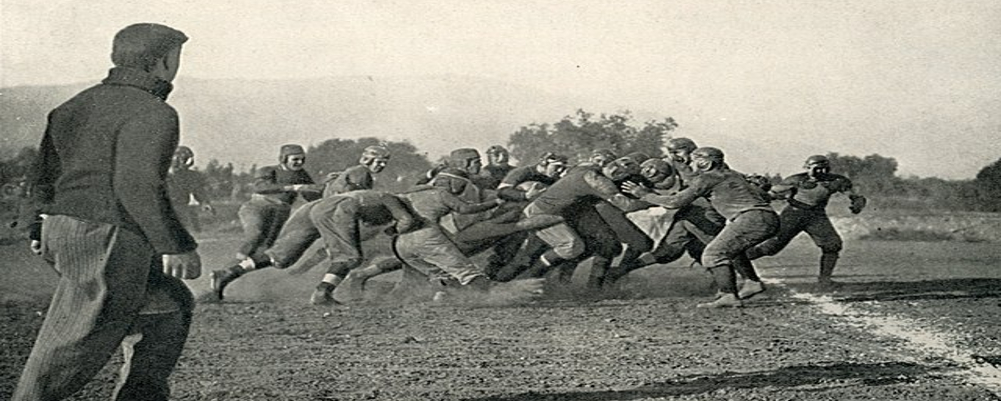The 1927 season is a defining moment in the New York Giants' rich history. Fresh off a winning, topsy-turvy first few seasons, the Giants, under the leadership of newly hired Head Coach Earl Potteiger, embarked on a campaign of dominance that cemented their place as a rising power in professional football. This edition explores the key factors that fueled the Giants' success in 1927, highlighting their exceptional play, strategic innovation, and the emergence of a true star running back.
Backdrop of the 1927 NFL
As we learned from past episodes of this series, the 1926 professional football season was a wild ride. Red Grange and C. C. Pyles's original American Football League had gone by the previous year's end. The death toll of the AFL was that group's champion, the Philadelphia Quakers, getting beaten fairly badly in an exhibition game by a somewhat pedestrian NFL team from 1926, the New York Giants.
Right before the 1927 season, the League eliminated the financially weaker, generally smaller-market teams. The results were quite evident when you look at the NFL standings 1926 versus those of 1927, when the franchise listing went from 22 to 12 teams. The National Football League absorbed many players and a defunct American Football League franchise. That team is Grange's New York Yankees.
The consolidation of NFL teams following 1926 indirectly aided the New York Giants. The Brooklyn Horsemen folded, but Tim Mara (Giants owner) strategically kept their charter active. This charter became a valuable bargaining chip when another team, the Brooklyn Horsemen (operated by Bill Carr), sought entry into the League. This time, Mara and partner J. Wellington Mara (no relation) held the upper hand.
Mara offered a solution: lease the Brooklyn Horsemen charter to Carr, allowing him to bring star player Red Grange back to the NFL under a new name – the "New York Football Yankees." However, to prevent competition with the Giants, the Yankees faced restrictions. They would primarily play on the road, with only a few home games strategically scheduled to avoid clashing with the Giants' home schedule. The season would culminate in a particular "City Championship" series, with the Giants and Yankees battling it out in a home-and-home format. C.C. Pyle had wanted all along.
This arrangement benefited all parties involved. Mara eliminated a potential rival while ensuring a lucrative rivalry with the Yankees. Carr got his team back in the NFL, and fans were treated to the return of Red Grange. The restricted schedule ensured the Yankees wouldn't overshadow the Giants, and the City Championship series added a unique twist to the season's finale.
With this resolution, Mara and Dr. Harry March could now focus on building their Giants' roster with talent that would compete with the rest of the NFL's best.
A Well-Oiled Machine: Balanced Offense and Stifling Defense
March's strategy was to solidify the trenches with veteran players to dominate the line of scrimmage. Center Mickey Murtagh was signed on to return to the lineup once again, and stars like Al Nesser of the famous Columbus, Ohio football family were added along with Hec Harvey and returning talent Doc Alexander, who served as a more than adequate backup. Steve Owen was another returning lineman from the previous season to further anchor stability and dominance up front.
On the ends of the line, the Giants were equally challenging. Chuck Corgan, Owen's teammate on the former Kansas City Cowboys traveling team, was on one side. At the same time, a rookie sensation in future Hall of Famer Cal Hubbard combated the opposition on the other flank. These terminals were as big as the interior, and they often bullied the point of attack from the outside, opening gaping holes for the talented backfield.
The hallmark of the 1927 Giants was their remarkable balance on both sides of the ball. Offensively, the team wasn't independent of a single player. The Giants boasted a diverse attack, keeping opposing defenses guessing with running plays and short passes.
Fullback Jack McBride emerged as the offensive leader, showcasing his versatility with rushing touchdowns, field goals, and extra points.
The amazing tailback Hinkey Haines was the lightning to McBride's thunder, creating a formidable tandem in the New York backfield. Blocking in front of them was Mule Wilson, a former Texas A&M gridiron and track star signed for '27 after playing for the now-disbanded Buffalo Rangers in the prior year. Wilson was a willing blocker, and his speed and athleticism allowed him to get out ahead of his talented backfield mates to provide more than ample interference for any defenders that had escaped the guys on the front line.
However, the Giants' defense truly set them apart. They led the League in both yards allowed and points conceded, showcasing a suffocating unit that shut down opposing offenses. Their defensive prowess was a testament to their relentless pursuit and disciplined tackling.
A Coaching Mastermind and Strategic Innovation
Head coach Earl Potteiger played a pivotal role in the Giants' success. He emphasized a team-first mentality, fostering a strong work ethic and a dedication to execution. Potteiger's innovative approach included the "shift," a pre-snap formation that confused opposing defenses and created running lanes for his backs. This strategic wrinkle kept opponents on their heels and contributed significantly to the Giants' offensive efficiency.
The Rise of a Star: Jack McBride Leads the Way
While the Giants thrived on a collective effort, running back Jack McBride emerged as an actual offensive weapon. He led the team in scoring, showcasing his power rushing and ability to catch passes out of the backfield. McBride's versatility and consistent play were instrumental in the Giants' offensive success. His leadership and on-field presence solidified his place as a critical building block for the burgeoning Giants dynasty.
A Championship Near Miss and a Legacy of Excellence
The 1927 Giants' season wasn't without its challenges. The fewer teams in the League had also increased the talent levels of many other franchises in the previously watered-down star-quality rosters.
The 1927 campaign started with a challenging road game against the Providence Steam Roller at the Cyclodrome. New York was the more dominant team throughout the contest. Still, the Providence eleven would not give in easily, as evidenced by a lost scoring opportunity in the early part of the contest when the Giants had the ball on the one-foot line but were denied entrance to the endzone. The only TD of the game would come on a McBride plunge over the goal line in the second quarter. The New York squad would add a safety later that period and then hold onto an 8-0 victory over their hosts.
The following week, on October 2, the Giants traveled to Cleveland and faced the Bulldogs with their new weapon, Benny Friedman. The defenses of both sides prevailed in what would end up a scoreless draw. A rematch would follow in two weeks after the Giants were road warriors again, this time traveling to Pottsville, where they dismantled the Maroons 19-0 on great runs by Jack McBride and a scoop and score by reserve Doc Alexander.
Their only loss and sole tie came the next game against the Cleveland Bulldogs, a testament to the competitive nature of the young NFL. After battling for two more periods of scoreless football, the drought was broken in the third quarter when Cleveland's Jinx Simmons found a gap in the New York front and took the leather over the goal line for the game's only score and a 6-0 Bulldog victory. This inability of the Giants to overcome Friedman and the company would motivate Tim Mara to join that team in the offseason after they morphed into the Detroit Wolverines.
The loss awoke the Giants for the rest of the season as they dominated the rest of their opposition, reeling on nine consecutive wins for the rest of their schedule. These games included two blankings of the tough Frankford Yellow Jackets in a Home-and-Home series (13-0 & 27-0), a rematch with Pottsville (16-0), blanking Ernie Nevers and the Duluth Eskimos 21-0, Providence 25-0, taking out both Chicago teams (Cardinal s 28-7 & Bears 13-7), before closing out the season against cross-town rivals the New York Yankees 13-0 and 14-0.
In this era of NFL titles based on overall league records, the Giants outpaced the 7-2-1 Green Bay Packers and the 7-3 Chicago Bears to be declared the NFL Champs of 1927 at League meetings after the season ended. This would be the first championship for the franchise in just their third year of existence.
The 1927 season it marked a turning point for the New York Giants. It showcased their potential as a powerhouse in the NFL and laid the groundwork for future success. The team's dedication to balance, strategic innovation, and the emergence of a star running back all contributed to their dominant season. The 1927 Giants established a winning culture and a legacy of excellence that inspires generations of New York Football Giants fans.


